JAPAN UNLEASHES KAMIKAZE HELL OFF OKINAWA
Off the Coast of Okinawa, Japan • April 6–7, 1945
For centuries the concept of individual suicide was accepted within Japanese society. Among the warrior, or Samurai, class especially, suicide was seen as the way to, among other things, atone for one’s failure, attenuate shame, and restore honor for oneself or for one’s family or clan. Ritual suicide by disembowelment, known as seppuku or harakiri, dates back to 1180 AD. Conversely, mass suicide emerged as a recent phenomenon. In the early days of World War II, Japanese aviators who had been taught in military training to avoid capture or surrender and whose aircraft were too badly damaged to return to base would fly their planes into an enemy plane (a tactic called “body crashing,” or taiatari), or into an enemy ship or some sort of ground target. The aviators’ last act was wrapped up in the feudal Japanese moral code of bushidō, “the way of the warrior.”
Suicide as a doctrinal military tactic, however, did not enter Japanese military policy until October 1944. Allied military forces of every sort threatened the very existence of the Imperial homeland. Vice Admiral Takijirō Ōnishi, recently appointed commander of the First Air Fleet headquartered in the Philippine capital Manila—and a pilot himself—championed a “special attack” force (tokubetsu kōgeki tai, abbreviated as tokkōtai; also called shimbu-tai) that would inflict maximum damage on Allied naval vessels strangling the island empire. Ōnishi’s strategy involved loading high explosives onto land-based aircraft that would be flown by youthful, mostly inexperienced naval aviators who reputably gloried in bushidō self-sacrifice as they crashed their planes into Allied vessels to sink or cripple them and kill as many sailors and Marines as possible. These 1‑way tokkotai pilots had been named after a “Divine Wind,” a kamikaze, that centuries earlier had saved Japan from a Mongol invasion. Ōnishi hoped to repeat his ancestors’ fate by using masses of 1‑way pilots in what were euphemistically called “special attack formations.”
Scoring the first official kill of Ōnishi’s special attack aircraft were 5 1‑way pilots flying Mitsubishi A6M Zeros. They were accompanied by 4 fighter escorts. The date, October 25, 1944, 5 days into the U.S. campaign to retake the Philippines (October 20, 1944, to September 2, 1945), saw 1 kamikaze pilot sink the escort carrier USS St. Lo, sending 140 of her service crew and officers to their deaths. Two other U.S. escort carriers were damaged in tokkotai death plunges but sustained few casualties. (An escort carrier was also sunk in the same Battle off Samar but by enemy surface gunfire.) Truly for members of the newly established Kamikaze Special Attack Corps, theirs was an auspicious start.
The kamikaze program moved into high gear on this date, April 6, 1945, and into the next with the advent of Operation Kikusui (“Floating Chrysanthemum”), a series of 10 large kamikaze raids between April 6 and June 22. An initial typhoon of more than 700 Japanese aircraft, fighter planes, conventional bombers, and escorts assaulted U.S. and British fleets off the Japanese island of Okinawa, invaded a week earlier by what would swell to 110,000 U.S. soldiers and Marines. For 19 hours it was pure kamikaze hell.
The number of ships sunk by these 1‑way aviators is a matter of debate. According to a wartime Japanese source, kamikaze missions sank 81 U.S., British, and Australian vessels and damaged another 195. American sources state upwards of 2,800 kamikaze attackers sank either 34 or 47 naval ships, damaged 368 others, and caused the deaths of 4,900 sailors and wounded more than 4,800. An Australian-Japanese source counted 57 ships sunk. Despite radar detection and cueing, airborne interception, pilot attrition, and massive anti-aircraft barrages, 14 percent of all kamikazes survived to score a hit on a ship; of those ships 8.5 percent sank. The damage inflicted by these aerial actors, however, neither prevented the capture of the Philippines, Iwo Jima, and Okinawa nor the inevitable surrender of the prostrate Japanese nation to Allied nations aboard the U.S. battleship Missouri on September 2, 1945.
Kazikaze Campaign 1944–1945: Japan’s Desperate Bid to Ward Off Defeat
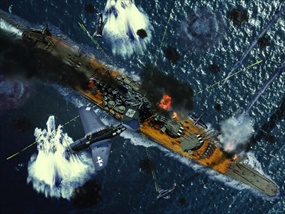 | 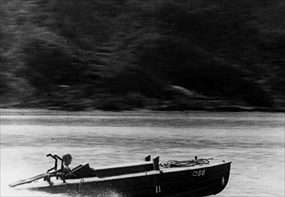 |
Left: The modern kamikaze concept spread from enemy-held Philippines to Japan’s Home Islands. From there it expanded to include manned suicide torpedoes (Kaiten, “Turn the Heaven”) and 2‑man midget submarines (Kaiyu, “Sea Dragon”), also human-piloted solid-rocket, 1‑ton bombs launched from mother aircraft near the target (Ohka, or “Cherry Blossom”), and small, shallow-draft plywood speedboats (Shin’yo, or “Sea Quake”) formed into land-based sea raiding squadrons intent on launching antiship rockets or dropping depth charges or other explosives near Allied supply vessels and landing craft. In a truly harebrained mission, the Japanese Navy sent the world’s largest battleship, its flagship Yamato, displacing 71,659 tons, to act as a “special attack weapon” during the Okinawa Campaign (Operation Iceberg, April 1 to June 22, 1945). Depicted in this artist’s impression are U.S. Navy dive bombers and torpedo bombers dispatching the pride of the Imperial Japanese Navy, along with 3,055 of her 3,332 crewmen, to the ocean bottom more than 300 nautical miles/556 kilometers north of Okinawa’s shores on the afternoon of April 7, 1945.
![]()
Right: Just prior to the Okinawa landings, U.S. Army soldiers secured a tiny group of bleak islands called Kerama Retto, 15 miles/24 kilometers west of Okinawa. There they put 3 Japanese sea-raiding squadrons out of business, seized and destroyed 350 high-speed (34.5 mph/55.5 km/h) Shin’yo boats that would have been used against the Allied invasion fleet, but not before 1 Army officer, Lt. Col. James F. Doyle, took a fast spin in one of them.
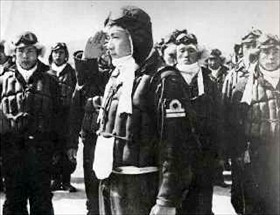 | 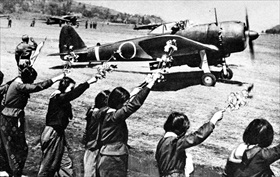 |
Left: A Japanese Navy kamikaze pilot in the rank of a lieutenant receives sortie orders. It is estimated that over 1,200 pilots (out of 2,314) perished in the Pacific War’s last desperate hurrah for Japan’s military leaders and their emperor Hirohito. Three-quarters of these pilots were teenagers barely out of school. From a Japanese perspective it is worth noting that the typical Japanese person then and now rejects the term “suicide attack” when speaking of kamikaze. The kamikaze pilot did not begin his 1‑way mission with the intention of committing suicide. He considered himself a pilot-guided lethal bomb that would cripple or destroy a certain part of the opponent’s fleet for his emperor and country. His was a glorious—though ultimately futile—act, while suicide may or may not be.
![]()
Right: Kamikaze flights found strong appeal in a nation with a long tradition of ritual suicide. Two or 3 pilots stepped forward for every available kamikaze plane, sometimes filling out their applications in blood. High school girls idolized the doomed heroes, who could not possibly change the course of the war. What the pilots could do, and indeed did, was make the eventual Allied victory more costly than otherwise. In this photo schoolgirls wave farewell with cherry blossom branches to 2nd Lt. Toshio Anazawa of Army Special Attack Unit (20th Shinbu Squadron; Shinbu means “military might”). Anazawa’s single-engine aircraft, a Nakajima Ki‑43 IIIa Army Type 1 fighter carrying a 550 pound/249 kilogram bomb, departed Kyūshū’s Chiran airbase at Kagoshima for Okinawa on April 12, 1945.
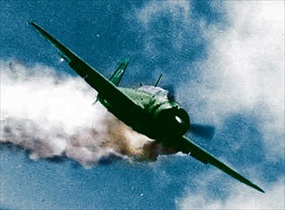 | 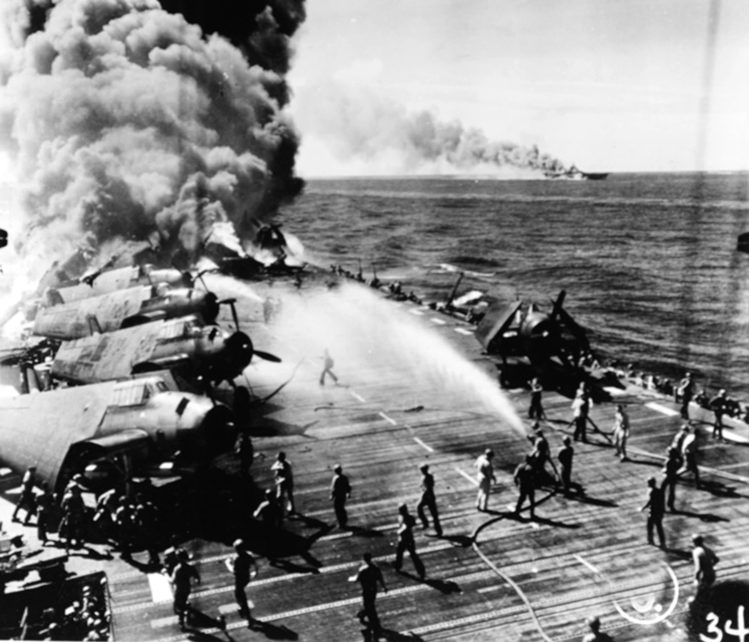 |
Left: A Yokosuka D4Y3 (Type 33 Suisei) “Judy” in a suicide dive against USS Essex on November 25, 1944. Lt. Yoshinori Yamaguchi’s plane hit the port edge of the Essex, landing among armed aircraft fueled for takeoff and causing extensive damage, killing 15 sailors and wounding 44. Difficult to see, the slotted dive flaps that reduce dive speed are extended, and the non-self-sealing port wing tank trails fuel vapor and/or smoke. Famously, a D4Y was used in one of the final kamikaze attacks in 1945, hours after the surrender of Japan on board the USS Missouri in Tokyo Bay on September 2, 1945.
![]()
Right: USS Belleau Wood burning after the light aircraft carrier shot down a kamikaze, which plunged onto its flight deck as the carrier operated off Luzon, Philippines, October 30, 1944. Ninety-two sailors either died or went missing in the mishap. Ablaze in the distance is the USS Franklin, also hit by kamikaze, which killed 56 men and wounded 60. Neither ship sank. By far the most successful and harrowing kamikaze attacks occurred as U.S. Marines and soldiers initiated their capture of Iwo Jima on April 1, 1945 (Operation Detachment). Between the Imperial Japanese Navy and the Imperial Japanese Army 940 aircraft and 887 aircraft, respectively, were deployed. Of these, 133 planes of varying types scored hits, and 122 planes scored near misses. Japanese casualties include 2,045 naval aviators and 1,022 army aviators killed (not including losses other than kamikazes). If non-kamikaze aircraft are included, 2,258 aircraft were lost. On the Allied side, 36 ships were sunk (but no cruisers or larger vessels), 218 ships were damaged (including 8 aircraft carriers, 3 battleships, 2 cruisers and 33 destroyers), and 763 carrier aircraft were lost. The British Pacific Fleet shot down more than 40 enemy aircraft for a loss of 44 men killed, 83 wounded, 4 aircraft carriers and 1 heavy cruiser damaged, and 1 minesweeper sunk. Total Allied casualties include over 4,900 killed or missing, and 4,824 wounded. In the history of the U.S. Navy, kamikazes caused the service’s greatest losses.
Contemporary Footage of Japanese Kamikaze Attack on U.S. Navy Fleet Off Okinawa, April 1945
![]()

 History buffs, there is good news! The Daily Chronicles of World War II is now available as an ebook for $4.99 on Amazon.com. Containing a year’s worth of dated entries from this website, the ebook brings the story of this tumultuous era to life in a compelling, authoritative, and succinct manner. Featuring inventive navigation aids, the ebook enables readers to instantly move forward or backward by month and date to different dated entries. Simple and elegant! Click
History buffs, there is good news! The Daily Chronicles of World War II is now available as an ebook for $4.99 on Amazon.com. Containing a year’s worth of dated entries from this website, the ebook brings the story of this tumultuous era to life in a compelling, authoritative, and succinct manner. Featuring inventive navigation aids, the ebook enables readers to instantly move forward or backward by month and date to different dated entries. Simple and elegant! Click 











